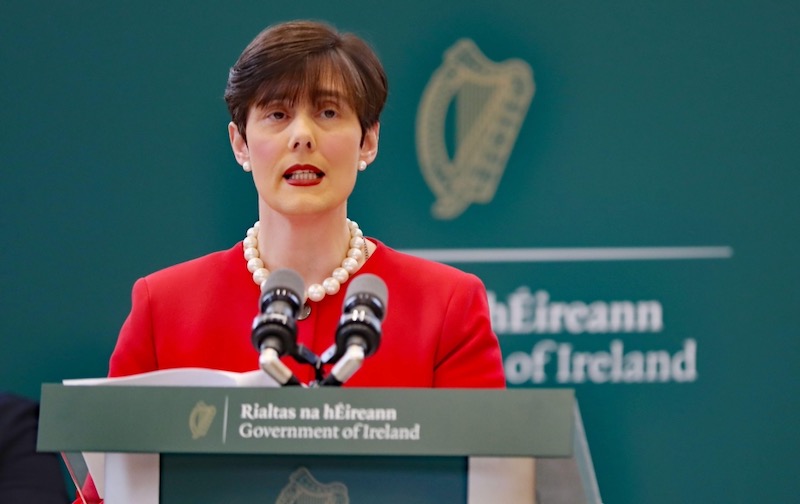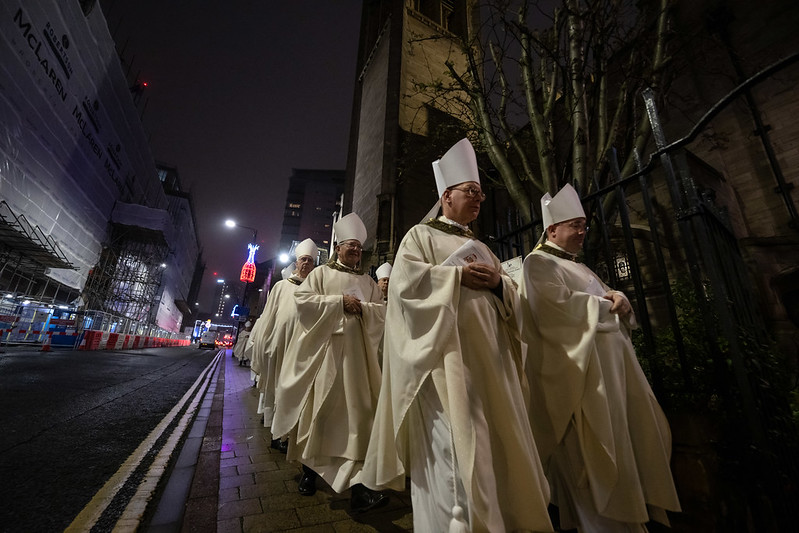The first day of the Bishops' plenary meeting in Leeds, Monday 14 November, ended with a Mass of Thanksgiving in Leeds Cathedral for Cardinal Arthur Roche, a former Bishop of the diocese. The Mass was attended by the English and Welsh bishops as well as faithful from across the diocese. Mass was celebrated in the Modern Roman Rite. It was a concelebration by the bishops of England and Wales, and Cardinal Roche was the Principal Celebrant. Cardinal Nichols gave the homily. On Tuesday 15 November, the bishops celebrated a Mass for two recently deceased bishops, Howard Tripp of Southwark and Mario Conti of Glasgow. Also last week, Cardinal Roche, also returned to his home parish in Leeds, St Joseph’s in Batley Carr, to celebrate his first Mass in the UK since becoming a Cardinal - and to gift his Cardinal’s red biretta to the church where he was baptised.
World War I chaplain Fr Willie Doyle “has something to say to our time when bridge builders are scarce,” Bishop Tom Deenihan said at a Mass to formally open the cause for the canonisation of the Irish Jesuit. In his homily at the Cathedral of Christ the King in Mullingar, the Bishop of Meath stressed that nationality, creed and political belief were “secondary and subservient to being a child of God” to Fr Doyle. He quoted from a recent article in the Tablet by Melanie McDonagh in which she recalled the journalist Sir Philip Gibbs’ description of Fr Doyle as “speeding all day, hither and thither, over the battlefield like an angel of mercy”. The priest was killed in the Battle of Langemarck on 16 August 1917.
Two Catholic Churches in the Diocese of East Anglia are to be defined as listed buildings by Historic England, placing them under higher levels of protection - and making it easier to apply for government funding. Diocese of East Anglia has more listed churches than any other Catholic diocese in England, and a recent review of Catholic Churches in the UK has added two more. St Felix’s church in Felixstowe and Our Lady of the Annunciation in King’s Lynn, have both been disgnated as Grade II listed buildings. A number of presbyteries have also been given protected status in the survey, and the well-known church of Our Lady and the English Martyrs in Cambridge (popularly known as OLEM) has been elevated to Grade I Listed – the highest form of listed building.
Catholic charities have welcomed the decision of the latest UN Climate Change Conference, COP27, to establish a loss and damage fund for nations vulnerable to climate-related disasters. Cafod, Sciaf and a number of other Catholic campaign organisations were amongst the groups calling for such a fund to be established at the conference. Neil Thorns, Cafod's director of advocacy and communications, said in response to the decision: “The establishment of a loss and damage fund is a major step forward in supporting communities whose lives, livelihoods and cultures have been destroyed by the climate crisis.” Cafod also drew attention to the progress made at the conference in furthering food chain resilience, which the charity describes as a key tool in preventing future climate-induced famine.
The bishops of England and Wales described proposals to introduce buffer zones excluding any form of protests around abortion clinics as “disproportionate and unnecessary”, in a resolution at their autumn plenary last week. They said they raise “questions about the state’s power in relation to the individual”. In Birmingham, a pro-life group has begun legal action against the city council for introducing a Public Spaces Protection Order around a clinic. Isabel Vaughan-Spruce who leads 40 Days for Life Birmingham is pursuing a statutory review, supported by the Christian Legal Centre. Clause Nine of the Public Order Bill, which will legislate for buffer zones nationally, was to be debated in the House of Lords on Tuesday 22 November.
St Mary’s University, Twickenham won a prize for outstanding support for students at the Times Higher Education awards on 17 November. The award was for the university’s “St Mary’s Cares” scheme, which offers a support package to students who have lived in local authority care, including a named contact and financial provision. The judges called it a “sincere and well-considered approach to supporting the complex needs of this sometimes-overlooked student group”
Leeds Trinity University has acquired a city-centre building to complement its existing campus in Horsforth, six miles from central Leeds. Students will have use of the building from the 2024/25 academic year. The vice-chancellor, Prof Charles Egbu, said the building would enhance “our ability to align with city-based partners and businesses as a career-led university”. He called the acquisition “a significant investment by the university, which will support our strategic ambitions to drive growth”. The National Student Survey for 2022 ranked Leeds Trinity eighteenth nationally for student experience and twenty-fourth for teaching quality.
The Margaret Beaufort Institute of Theology has put its 36-bedroom premises in a conservation area in Cambridge on the market for £5 million. The three-storey Edwardian building with modern extensions, including a library, chapel, detached coach house, gardens and more, stands in 1.12 acres. In a statement on its website the institute says: “We have engaged in new and interesting research, teaching, pastoral outreach and in new partnerships… Running a large old building is a huge undertaking and is not in line with the sustainability mindset.”
The Dominicans have departed Waterford city which has been home to the order’s friars since 1226. The decision to leave was taken last year in light of the ageing and declining number of vocations. There were just two Dominican friars still ministering in Waterford at St Saviour’s friary. Provincial Fr John Harris explained in a statement that the Dominicans in Ireland had to re-group in a smaller number of centres. “With fewer than 50 members under the age of 65, we physically cannot continue to staff all our existing 19 centres,” he said. “Dominicans work as communities: the Order’s Constitutions require that they be normally of no fewer than six brothers.” In 2014, the Dominicans withdrew from five centres in Ireland and closed houses in Limerick, Athy, Drogheda, Ballybeg and Ranelagh in Dublin. Since then 31 brothers have died.
Irish theologian Fr Donal Dorr has stated publicly that he believes that Church authorities are wrong not to allow the ordination of women as priests. In his address to the lay reform group, We Are Church Ireland, on the topic “Synodality and the Ordination of Women: What Would Jesus Do?” Fr Dorr reiterated his view which he had previously outlined in an article in The Furrow magazine. Noting that most debate about the ordination of women is conducted in terms of Church law, he said he preferred to think of the issue in scriptural terms and the development of Church teaching and synodality. The question was not what would Jesus do but what did Jesus do. “He formed and nurtured a community of women and men,” the author and missionary said.



 Loading ...
Loading ...